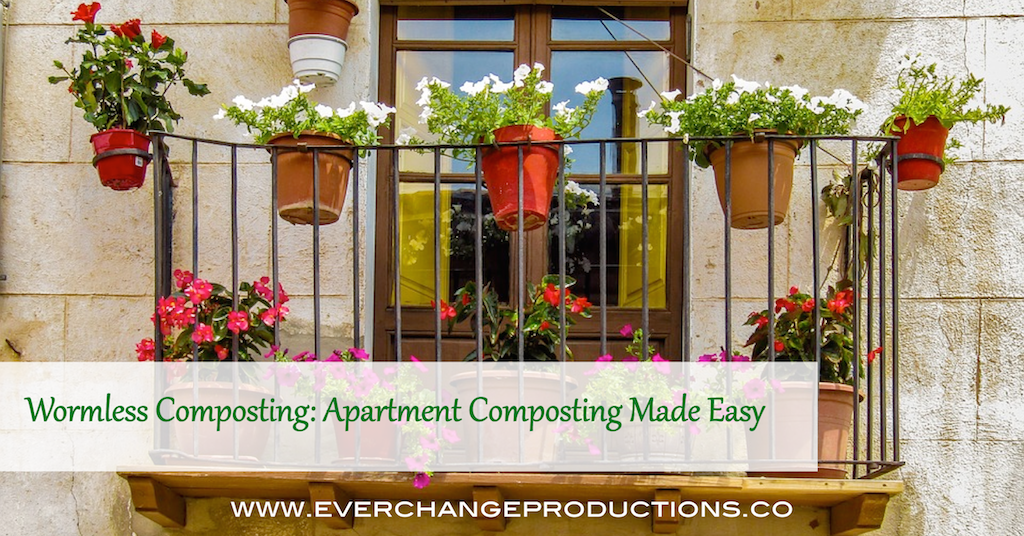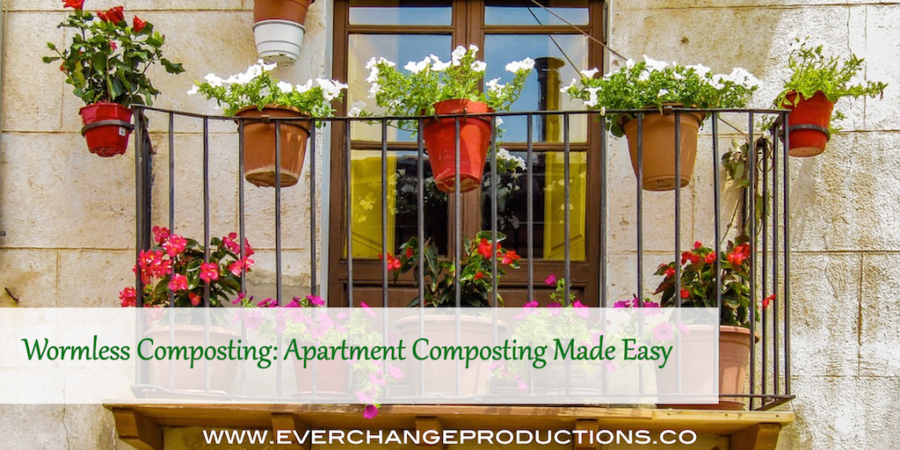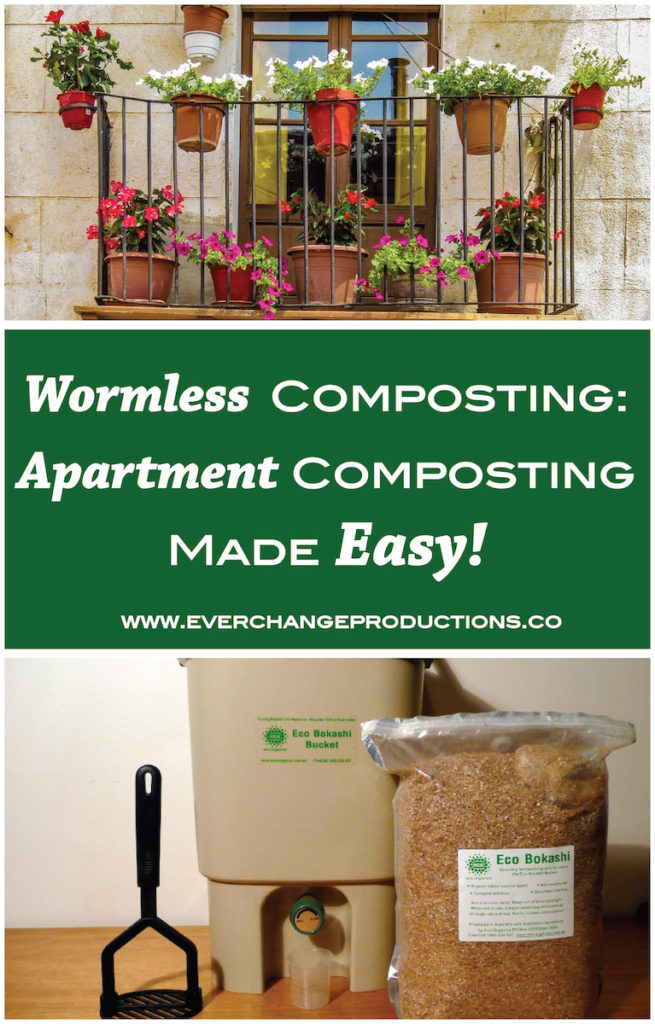
Why Compost in an Apartment?
You’re here! This means, I’m guessing, you have your own solid reason for wanting to compost even if you live in an apartment or in a space you don’t own or don’t have a garden. I get this question all the time, so I’ve decided to address it just in case you’re on the fence.
Most people consider composting only something a hardcore farmer or gardener would do. While it’s true that compost has all kinds of wonderful benefits for the soil, that’s not all.
It helps build the structure and adds nutrients necessary for plants to grow. When people talk about the benefits of compost, this part is key. While poor farming practices and other land use is a growing issue that compost addresses, there is another aspect we need to consider. Food waste.
To reduce food waste has enough benefit to make composting worth it, even if that compost never makes to the land.
And there’s two major reasons why this is the case.
First, the process causes food waste to shrink by about 80 percent as it decomposes. Even if (yes, this is crazy) you throw your compost away, then, and you’ll still be reducing the volume of garbage going to your landfill. Most people overestimate how much compost they end up with. There’s not enough compost to dispose of to create an issue.
Second, proper composting can help reduce greenhouse gas emissions from your trash. Because organic materials don’t have oxygen in the landfill, it causes anaerobic (without air) decomposition. This process releases methane gas, which is about 20 times more harmful than carbon dioxide. This gas is also combustible and the liquids from the decomposing process could potentially leach into our water supply. Therefore, landfills have an expensive liner and collection system to prevent these potential hazards.
What Can You Compost Indoors
If you want to know how to compost in an apartment, first you need to know what you can actually compost indoors. When you compost in an apartment or indoors, it’s important to watch what you put in the compost bin. You don’t want to draw any visitors or make your apartment stink. Refer back to list anytime you need and make sure you don’t try composting something to invite new visitors.
Never compost meat, dairy, citrus, oils, cooked foods, spicy food, salty food or foods with preservatives. There is a couple of exceptions that we’ll discuss in the wormless composting option section.
Brown or carbon rich materials should make up at least 50 percent of compost. These materials include newspaper, paper (printed with soy ink for worms), cardboard, wood chips, straw or hay, and leaves.
The green or nitrogen materials, include fruits, vegetables, coffee grounds, tea bags, hair, eggshells, coffee filters, and cooked pasta.
The key is to make sure you have the right balance of brown versus green. If you’re compost starts to stink or draws flies, add dry browns and back off of the green until it balances back out.
Wormless Composting Options
So now that we’ve got that out of the way, let’s get back to the wormless composting options for apartments.
Apartment composting without worms
Although, I’m a huge fan of composting with worms, I know it’s a turn off for most people in apartments. Luckily, there is still a few options for those wanting to know how to compost in an apartment…without worms.
Wormless Apartment Composting DIY
- Materials Needed:
- Dried Leaves
- 8 oz of top soil
- Can of used coffee grounds
- Large Bucket
- A little water
If you have a bucket lid, make sure it has plenty of holes. If your bucket doesn’t have a lid, use a porous towel to cover the top. Air is an important component for compost. Mix the compost fairly often to aerate and increase microbial activity.
You can find variations of this method throughout YouTube, so take a browse to find a method that works for you. Composting takes anywhere from six weeks to a year.
Compost Bin for Small Yards and Balconies
If you have a little space outdoors to work with, then a small tumbler like this one might be an option.
Compost tumblers, as opposed to compost bins, are designed to make it easier to turn the compost. You’ll only need to spin the drum a few times a week. They are a tad smaller than a compost bin. However, they speed the composting process by making it easy to mix the materials, They are sealed on the bottom, so if you rent property, you don’t have to worry about cleaning up after the compost bin. The seal also helps the compost heat up more, speeding up the compost more. This system gives you the ability through batches in about 6 – 8 weeks. You can learn more about the compost bins vs. compost tumblers.
Compost bin for apartment dwellers
Full disclosure: I have do not have a lot of answers on how to compost in an apartment without worms. According to what I’ve read, you need at least one cubic yard of composting space for the materials to get hot enough to compost. However, these following composting bins had positive reviews, so I wanted to make the options available for those interested in trying.
If you’re looking for more of a compost bin for indoors, then this compost bin might be the way to go. This compost bin fits under the kitchen sink or on the counter top. It has excellent ratings on Amazon, but some folks did complain about the color and fruit flies.
This 1-gallon Lattice Ceramic kitchen composter also has great reviews, and I didn’t find complaints of fruit flies. It would definitely look adorable on your kitchen counter!
Bokashi Composting
This indoor composter actually ferments your food. This system is one of the exceptions to the green:brown ratio we mentioned earlier. This option is quite different than any other composting option. I never thought it was worth the trouble, but I recently met someone who went on and on about the Bokashi Composting option, so I might give it a chance. It’s worth noting that you can use kitchen scraps of all kinds, including meat and dairy products banned from aerobic systems. Once you fill it with kitchen scraps you mix with some of the inoculated bran, press it and cover with another handful of bran.
When the bucket is full, it is sealed shut and set aside for ten to twelve days. Every other day during that time, the leachate that is an inevitable byproduct of anaerobic composting needs draining. This is very easy with a commercial Bokashi Bucket which has a spigot for this purpose.)
The contents aren’t actually composted, but more like pickled. At this stage, the “pre-compost” as one company brochure terms it can be buried in a fallow spot in the garden. It’s not actually compost, so it’s too acidic for plant roots for another two to four weeks. Check out this thorough post about Bokashi Composting for more information.
Electric Composter
Although, I have my reservations about how eco-friendly these are in the production process, these are still great options for the apartment composter. It composts everything including dairy, cooked foods, and chicken and fish bones. It reduces food scraps up to 90 percent in about 3 hours using only 1 kwh. These cycler creates 54 percent less CO2 than a regular composter in your backyard, and it releases 94 percent less greenhouse gases than your average landfill.
There are several electric composter options, but I have used The Food Cycler Platinum and works great for me.
Related Life Skills for Good Living
Check out some of my other resources about green apartment living: 18 Ways Renters Can Save Money, Apartment Composting with Worms, Sustainable Apartment Living, and Gardening in Small Spaces.
Green Apartment Living
When you don’t have complete control over your living circumstances, it can seem impossible for renters to save money or energy. However, green apartment living isn’t as difficult as some might think. It’s important to remember renters can save money. Just start small and be encouraged by those differences that start to add up. These tips or combinations will help save green, not just for our pocketbooks, but also for the environment. For a complete guide to green apartment living, check out this book:
Apartment Composting without Worms Conclusion
As you can see, there are many options to compost without worms that make apartment composting possible. Leave a comment, if you have tried these ideas, have any tips or questions about their use!
Happy Composting!
Interested in composting, but don’t know where to start? Subscribe for access to a free quiz and find the best composting option for you.

